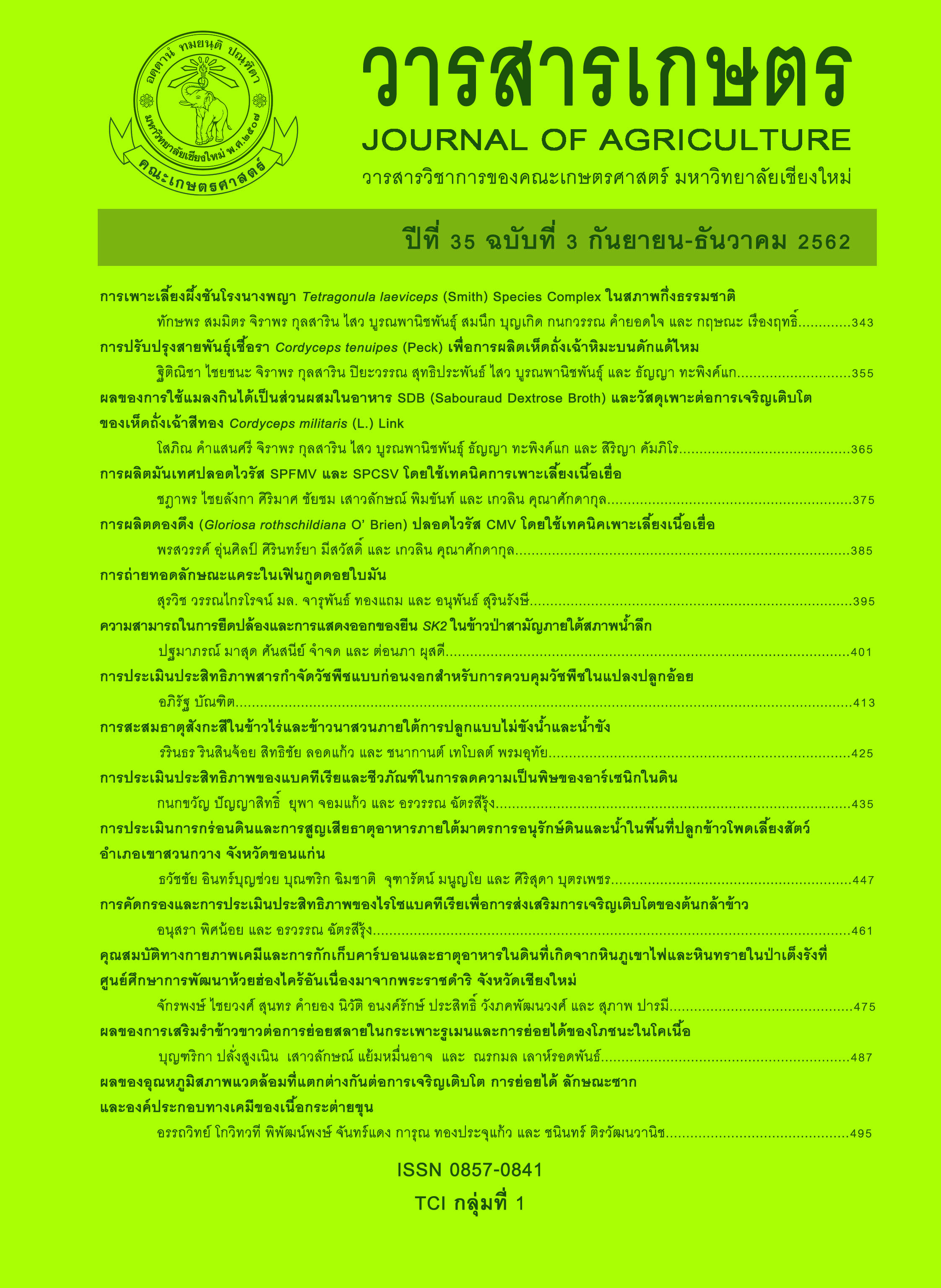ผลของการใช้แมลงกินได้เป็นส่วนผสมในอาหาร SDB (Sabouraud Dextrose Broth) และวัสดุเพาะต่อการเจริญเติบโตของเห็ดถั่งเฉ้าสีทอง <I>Cordyceps militaris</I> (L.) Link
Main Article Content
บทคัดย่อ
เห็ดถั่งเฉ้าสีทอง (Cordyceps militaris (L.) Link) มีสารออกฤทธิ์ที่มีสรรพคุณทางยาและใช้บริโภคเพื่อปรับสมดุลในร่างกาย ได้แก่ cordycepin และ adenosine เห็ดชนิดนี้เป็นเชื้อราที่เจริญเติบโตได้ดีในแมลงหลายชนิดในอันดับ Lepidoptera, Orthoptera และ Coleoptera โดยเฉพาะแมลงกินได้ จึงทำการศึกษาผลของแมลงกินได้เป็นส่วนผสมในอาหาร Sabouraud dextrose broth (SDB) และวัสดุเพาะ ต่อการเจริญเติบโตและการสร้างสารออกฤทธิ์สำคัญของเห็ดถั่งเฉ้าสีทอง โดยใช้แมลงกินได้ทดสอบ 4 ชนิด ได้แก่ หนอนไหมก่อนเข้าดักแด้ และดักแด้ไหม ตัวเต็มวัยจิ้งหรีดพันธุ์ทองดำ หนอนเยื่อไผ่ และหนอนนก ผลการศึกษาพบว่า อาหาร SDB ผสมจิ้งหรีด ให้ค่าความมีชีวิตสูงสุดที่ 3.5 x 103 หน่วยโคโลนีต่อมิลลิลิตร และเมื่อนำอาหาร SDB นี้ ถ่ายลงวัสดุเพาะที่ประกอบด้วยข้าวไรซ์เบอรี่ (Riceberry) และข้าวขาวดอกมะลิ 105 (KDML 105) ผสมแมลงกินได้ชนิดต่าง ๆ พบว่า ก้านดอกเห็ดบนวัสดุเพาะข้าวขาวดอกมะลิ 105 ผสมดักแด้ไหม มีความยาวสูงสุดเท่ากับ 3.14 เซนติเมตร ขณะที่น้ำหนักสดและแห้งเฉลี่ยสูงสุดของก้านดอกเห็ดได้จากการเพาะบนวัสดุเพาะข้าวไรซ์เบอรี่ผสมหนอนไหมก่อนเข้าดักแด้ มีค่าเท่ากับ 5.56 และ 1.17 กรัม ตามลำดับ ก้านดอกเห็ดบนวัสดุเพาะข้าวขาวดอกมะลิ 105 ผสมจิ้งหรีด ตรวจพบว่ามีสาร cordycepin ปริมาณมากที่สุด เท่ากับ 1,266.74 มิลลิกรัม/100 กรัม ส่วน adenosine พบมากที่สุดในวัสดุเพาะข้าวขาวดอกมะลิ 105 ผสมจิ้งหรีด ปริมาณ 94.91 มิลลิกรัม/100 กรัม ผลการศึกษานี้ช่วยให้เห็นแนวทางในการพัฒนาและเสริมสร้างเทคนิคในการเพาะเลี้ยงเห็ดถั่งเฉ้าสีทองแก่เกษตรกรและนักวิจัยในอนาคตต่อไป
Article Details
เอกสารอ้างอิง
Almagro, L., A.B. Sabater-Jara, S. Belchi-Navarro, F. Fernandez-Perez, R. Bru and M.A. Pedreno. 2011. Effect of UV light on secondary metabolite biosynthesis in plant cell cutures elicited with cyclodextrins and methyl jasmonate. pp. 115-136. In: H. Vasanthaiah (ed.). Plants and Environment. InTech, Rijeka.
Dong, J.Z., M.R. Liu, C. Lei, X.J. Zheng and Y. Wang. 2012. Effects of selenium and light wavelengths on liquid cuture of Cordyceps militaris Link. Applied Biochemistry and Biotechnology 166(8): 2030-2036.
Hong, I.P., P.D. Kang, K.Y. Kim, S.H. Nam, M.Y. Lee, Y.S. Choi, N.S. Kim, H.K. Kim, K.G. Lee and R.A. Humber. 2010. Fruit body formation on silkworm by Cordyceps militaris. Mycobiology 38(2): 128-132.
Huang, L., Q. Li, Y. Chen, X. Wang and X. Zhou. 2009. Determination and analysis of cordycepin and adenosine in the products of Cordyceps spp. African Journal of Microbiology Research 3(12): 957-961.
Khan, M.A., M. Tania, D. Zhang and H. Chen. 2010. Cordyceps mushroom: A potent anticancer nutraceutical. The Open Nutraceuticals Journal 3(1): 179-183.
Leejae, S., N. Bakasatae, W. Intamon, C. Korkitpaisal, T. Sudsai and A. Prapaiwong. 2015. Antioxidant activity of caterpillar fungus (Cordyceps militaris) grown on rice berry and jasmine rice. pp. 210-217. In: Proceedings of RSU National Research Conference 2015. Rangsit University, Pathum Thani. (in Thai)
Luerdara, K., J. Kulsarin, S. Buranapanichpan and T. Tapingkae. 2016. Growth of gold cordyceps (Cordyceps militaris) on pupae of Nanglai Thai native silkworm and eri silkworm. Journal of Agriculture 32(1): 95-102. (in Thai)
Mao, X.B. and J.J. Zhong. 2006. Significant effect of NH4+ on cordycepin production by submerged cultivation of medicinal mushroom Cordyceps militaris. Enzyme and Microbial Technology 38: 343-350.
Mao, X.B., T. Eksriwong, S. Chauvatcharin and J.J. Zhong. 2005. Optimization of carbon source and carbon/nitrogen ratio for cordycepin production by submerged cultivation of medicinal mushroom Cordyceps militaris. Process Biochemistry 40: 1667-1672.
Masuda, M., E. Urabe, H. Honda, A. Sakurai and M. Sakakibara. 2007. Enhanced production of cordycepin by surface culture using the medicinal mushroom Cordyceps militaris. Enzyme and Microbial Technology 40(5): 1199-1205.
Sato, H. and M. Shimazu. 2002. Stromata production for Cordyceps militaris (Clavicipitales: Clavicipitaceae) by injection of hyphal bodies to alternative host insects. Applied Entomology and Zoology 37(1): 85-92.
Shrestha, B., W.H. Lee, S.K. Han and J.M. Sung. 2006. Observations on some of the mycelial growth and pigmentation characteristics of Cordyceps militaris isolates. Mycobiology 34(2): 83-91.
van Huis, A., J. van Itterbeeck, H. Klunder, E. Mertens, A. Halloran, G. Muir and P. Vantomme. 2013. Edible Insects: Future Prospects for Food and Feed Security. FAO Forestry Paper 171. FAO, Rome.
Zhang, A.L., J.H. Lu, N. Zhang, D. Zheng, G.R. Zhang and L.R. Teng. 2010. Extraction, purification and anti-tumor activity of polysaccharide from mycelium of mutant Cordyceps militaris. Chemical Research in Chinese Universities 26(5): 798-802.
Zhang, Q., Y. Liu, Z. Di, C.C. Han and Z. Liu. 2016. The strategies for increasing cordycepin production of Cordyceps militaris by liquid fermentation. Fungal Genomics and Biology 6: 134, doi: 10.4172/2165-8056.1000134.


